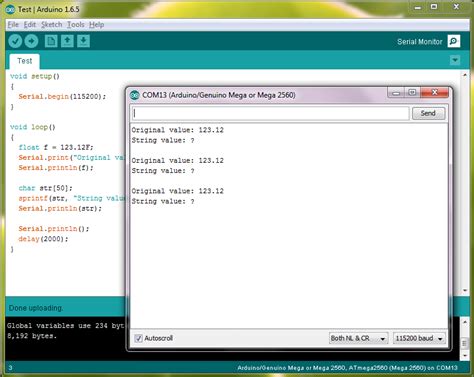arduino print float 3 decimal places ,Arduino prints float/double variable with decimal places,arduino print float 3 decimal places, By default, Serial.print() prints floats with two decimal digits. float num = 7.875; Serial.println(num, 4); will print num with 4 decimal digits, thus: 7.8750. The precision of float is . Remove the SIM or USIM card. Insert the tray back into the tray slot. Using dual SIM or USIM cards (dual SIM models) If you insert two SIM or USIM cards, you can have two phone numbers or service providers for a single device. Page .
0 · How to print a float with 3 decimal places
1 · Serial.print for floating numbers
2 · Arduino prints float/double variable with decimal places
3 · Setting float to two decimal places
4 · Help!! I need more decimal places in float.
5 · how to save float with 3 decimal places [duplicate]
6 · Only 2 decimal places in printed float
7 · arduino
8 · Reduce decimals while printing in Arduino
9 · How do I get a float number to decimal places

Ang Arduino ay isang napakalakas na platform para sa iba't ibang proyekto, mula sa simpleng pagkontrol ng LED hanggang sa mas komplikadong sensor data acquisition at processing. Isa sa mga karaniwang hamon na kinakaharap ng mga developer ay ang pagpapakita ng floating-point numbers nang may sapat na katumpakan, lalo na kapag kailangan ang tatlong decimal places. Sa artikulong ito, tatalakayin natin ang iba't ibang paraan para makamit ito, ang mga limitasyon ng Arduino, at mga best practices para sa pagharap sa floating-point arithmetic. Sasagutin din natin ang mga karaniwang tanong tulad ng "Paano mag-print ng float na may 3 decimal places?", "Bakit dalawa lang ang decimal places na lumalabas?", at "Paano ko mai-save ang float na may 3 decimal places?"
Ang Hamon ng Floating-Point Numbers sa Arduino
Ang Arduino IDE (Integrated Development Environment) ay gumagamit ng isang simpleng paraan para i-print ang floating-point numbers sa pamamagitan ng `Serial.print()` o `Serial.println()` functions. Gayunpaman, by default, limitado lamang ito sa dalawang decimal places. Ito ay maaaring maging problema kung kailangan mo ng mas mataas na precision para sa iyong mga kalkulasyon o display. Halimbawa, kung gumagamit ka ng sensor na nagbibigay ng readings na may tatlong decimal places (e.g., temperatura, boltahe), kailangan mong tiyakin na ang Arduino ay maipapakita ang mga readings na ito nang tama.
Mga Paraan para Mag-Print ng Float na May 3 Decimal Places
Mayroong ilang mga paraan para ma-overcome ang limitasyong ito at ma-print ang floating-point numbers na may 3 decimal places sa Arduino:
1. Gamit ang `Serial.print()` na may Pangalawang Argumento:
Ito ang pinakasimpleng at pinakadirektang paraan. Ang `Serial.print()` function ay tumatanggap ng isang opsyonal na pangalawang argumento na nagtatakda ng bilang ng decimal places na ipapakita.
```arduino
float myFloat = 3.14159;
Serial.print(myFloat, 3); // Ipi-print ang "3.142"
```
Sa code snippet na ito, ang `myFloat` variable ay may value na 3.14159. Ang `Serial.print(myFloat, 3)` ay magpi-print sa serial monitor ng "3.142". Pansinin na ang Arduino ay magro-round up sa pinakamalapit na digit kung ang ika-apat na decimal place ay 5 o mas mataas.
2. Gamit ang `dtostrf()` Function:
Ang `dtostrf()` (double to string format) function ay nagko-convert ng double (o float) sa isang character array (string) na may specific na format. Ito ay mas flexible kaysa sa simpleng `Serial.print()` dahil binibigyan ka nito ng kontrol sa kabuuang width ng string, pati na rin ang bilang ng decimal places.
```arduino
float myFloat = 123.45678;
char buffer[20]; // Kailangan ng buffer para i-store ang string
dtostrf(myFloat, 6, 3, buffer); // Kabuuang width: 6, 3 decimal places
Serial.print(buffer); // Ipi-print ang "123.457"
```
Sa code na ito:
* `dtostrf(myFloat, 6, 3, buffer);` Ang `dtostrf()` function ay ginagamit para i-convert ang `myFloat` variable sa isang string.
* Ang unang argumento ay ang floating-point number na ico-convert.
* Ang pangalawang argumento (6) ay ang minimum width ng string. Kung ang numero ay mas maikli kaysa sa width na ito, pupunan ito ng leading spaces.
* Ang pangatlong argumento (3) ay ang bilang ng decimal places.
* Ang pang-apat na argumento ay ang character array (buffer) kung saan i-store ang resulta.
Mahalagang tandaan na ang buffer size (`char buffer[20];`) ay dapat na sapat para i-accommodate ang string, kasama ang decimal point, negative sign (kung kinakailangan), at ang null terminator ('\0').
3. Gamit ang `String()` Object:
Maaari mo ring gamitin ang `String()` object para i-format ang floating-point number. Bagama't mas madali itong gamitin, tandaan na ang paggamit ng `String()` object ay maaaring magdulot ng memory fragmentation sa Arduino, lalo na sa mga long-running projects.
```arduino
float myFloat = 0.01234;
String myString = String(myFloat, 3);
Serial.print(myString); // Ipi-print ang "0.012"
```
Ang `String(myFloat, 3)` ay lumilikha ng isang `String` object na naglalaman ng floating-point number na na-format na may 3 decimal places.
4. Manual na Pagmamanipula ng mga Numero:
Kung kailangan mo ng ganap na kontrol sa formatting, maaari mong manual na i-manipulate ang numero gamit ang integer arithmetic. Ito ay maaaring mas kumplikado, ngunit maaaring mas efficient sa memorya at processing power.
```arduino
float myFloat = 0.98765;
int integerPart = (int)myFloat;
int decimalPart = (int)((myFloat - integerPart) * 1000);
Serial.print(integerPart);
Serial.print(".");
if (decimalPart < 100) {
Serial.print("0");
}
if (decimalPart < 10) {
Serial.print("0");
}
Serial.print(decimalPart); // Ipi-print ang "0.987"

arduino print float 3 decimal places At 2nd level, you adopt a particular style of fighting as your specialty. Choose one of the following options. You can't take a Fighting Style option more than once, even if you later get to choose again. 1. Archery.You gain a +2 bonus to attack rolls you . Tingnan ang higit pa
arduino print float 3 decimal places - Arduino prints float/double variable with decimal places